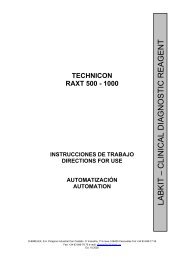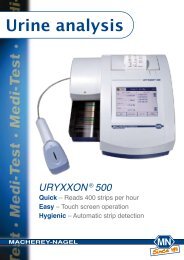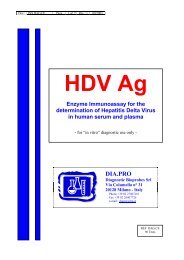[Protein C antigen rocket]. - Agentúra Harmony vos
[Protein C antigen rocket]. - Agentúra Harmony vos
[Protein C antigen rocket]. - Agentúra Harmony vos
Create successful ePaper yourself
Turn your PDF publications into a flip-book with our unique Google optimized e-Paper software.
PROTEIN C ROCKET EID<br />
INTENDED PURPOSE<br />
The <strong>Protein</strong> C Rocket EID (electroimmunodiffusion) procedure is intended for the quantitative<br />
determination of plasma protein C <strong>antigen</strong> by Laurell <strong>rocket</strong> electrophoresis 1, 2 .<br />
<strong>Protein</strong> C is a vitamin K dependent plasma protein that functions as a regulator of fibrin formation.<br />
In its activated form, it inhibits thrombin formation by the inactivation of activated factors V and VIII 3, 4 .<br />
A deficiency of protein C constitutes a thrombotic risk factor 5, 6 of which superficial thrombophlebitis<br />
is the most common clinical feature 7 . The virtual absence of plasma protein C has led to fatal<br />
thrombosis in neonates 8 .<br />
The Helena <strong>Protein</strong> C Rocket EID Procedure is performed in a 1% agarose gel medium containing an<br />
antiserum specific for protein C. After the plasma specimens are applied to the wells in the agarose,<br />
electrophoresis is used to migrate the proteins into the antibody field. A <strong>rocket</strong>-shaped precipitin<br />
pattern forms along the axis of migration. The length of this <strong>rocket</strong> pattern is proportional to the<br />
<strong>antigen</strong> concentration.<br />
WARNINGS AND PRECAUTIONS<br />
The reagents contained in this kit are for in-vitro diagnostic use only - DO NOT INGEST. Wear gloves<br />
when handling all kit components. Refer to the product safety data sheets for risk and safety phrases<br />
and disposal information. Plasma products have been screened and found negative (unless otherwise<br />
stated on the kit box or vial) for the presence of Hepatitis B Antigen (HbsAg) HIV 1 and 2 antibody and<br />
HCV antibody, however they should be handled with the same precautions as a human plasma sample.<br />
COMPOSITION<br />
1. <strong>Protein</strong> C Antigen Rocket Plates (Cat. No. 5357)<br />
Contains sheep or goat antibody to human protein C incorporated into agarose in Tris-tricine<br />
buffer 8 and sodium azide as preservative. To prevent the formation of toxic vapors, sodium azide<br />
should not be mixed with acidic solutions.<br />
Preparation: Remove the plate from the protective packaging and allow 5-20 minutes for the<br />
agarose to reach 15...30°C.<br />
2. Tris-tricine Buffer (Cat. No. 5358 - not included)<br />
Diluted buffer contains 0.08 M Tris and 0.024 M tricine.<br />
Preparation: Dilute one package of buffer to 1000ml with deionized or distilled water.<br />
The buffer is ready for use when all material is completely dissolved.<br />
3. Rocket Stain (Cat. No. 5362 - not included)<br />
Rocket Stain is Coomassie Brilliant Blue stain.<br />
Preparation: Dissolve the contents of the vial in 450ml deionized water, 450ml methanol and<br />
100ml acetic acid. Mix thoroughly and filter before use if necessary.<br />
4. Other kit components<br />
Each kit contains Instructions For Use, a <strong>rocket</strong> ruler and report form.<br />
STORAGE AND SHELF LIFE<br />
Unopened reagents are stable until the given expiry date when stored under conditions indicated on<br />
the vial or kit label.<br />
1. <strong>Protein</strong> C Antigen Rocket Plates (Cat. No. 5357)<br />
Rocket Plates MUST be stored at 2...6°C and maintained in moist condition within the bag.<br />
DO NOT FREEZE. The plates are stable until the expiry date indicated on the package.<br />
Signs of Deterioration: Discard the plate if dry in appearance or if the wells are not round.<br />
A crystalline appearance indicates the agarose has been frozen.<br />
1<br />
English


![[Protein C antigen rocket]. - Agentúra Harmony vos](https://img.yumpu.com/37734752/3/500x640/protein-c-antigen-rocket-agentara-harmony-vos.jpg)
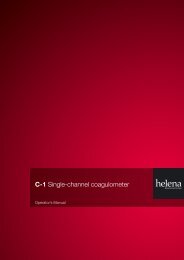
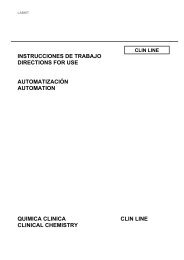
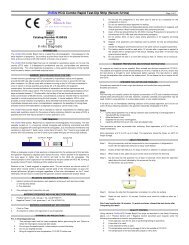
![[APTT-SiL Plus]. - Agentúra Harmony vos](https://img.yumpu.com/50471461/1/184x260/aptt-sil-plus-agentara-harmony-vos.jpg?quality=85)


![[SAS-1 urine analysis]. - Agentúra Harmony vos](https://img.yumpu.com/47529787/1/185x260/sas-1-urine-analysis-agentara-harmony-vos.jpg?quality=85)


![[SAS-MX Acid Hb]. - Agentúra Harmony vos](https://img.yumpu.com/46129828/1/185x260/sas-mx-acid-hb-agentara-harmony-vos.jpg?quality=85)

